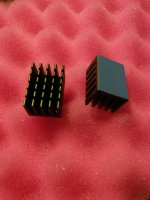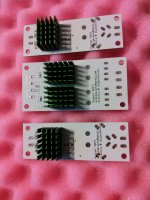Hi folks,
I have busy lately and I have built some PCBs with TPS7A4700 regulator. This is a low noise regulator with output capable of 1A.
Specs
Input voltage range: 2.2V to 25V AC, 3V to 36V DC
Output voltage range: 1.4V to 20.5V DC
Output voltage noise: 4uVrms (10Hz, 100kHz)
Dropout voltage: 350mV at 1A
Output current: 1A (with sifficent heatsink)
More details
-Output voltage is configurable via solder jumpers
-Sensing pins for better performance, DUAL PCB has sensing for positive voltage only, SINGLE PCB has sensing for positive and negative voltage, if not used they can be bridged to output via solder jumpers
-DUAL PCB can be easily configured to operate in symmetrical or single voltage output (solder jumper), transformer with dual secondary windings is a must when you use symmetrical output
-SINGLE PCB can have better capacitor in sensing circuit, there is space for 5mm lead spacing capacitor (for example: Wima 1uF/63V PET)
-DUAL PCB uses bridge rectifier, SINGLE PCB uses rectifying diodes to convert AC voltage to DC voltage.
-user can fit 0805 LED diode and dedicated resistor to indicate working state of regulator
PCB size & colour
-DUAL PCB: 77mm x 37mm
-SINGLE PCB: 75mm x 26mm
-all PCBs are in black colour
What is in the offer?
TPS7A4700 single voltage output 21€
What do you get for the price
Single PCB with smt components soldered on 1pcs
SBYV27 rectifying diode 4pcs
Epcos 1uF/63V PET capacitor 1pcs
Screw PCB connector 2pcs
attached aluminum block 1pcs (works as heatsink or heatbridge)
M3 nuts 4pcs
standoffs 4pcs
Panasonic FR capacitor 1pcs
Shipping & fees, payment
Priority shipping worldwide for one PCB is 3€,for each additional PCB you'll have to add 1€. I accept only PAYPAL, fees are included in the price. You'll receive invoice for what you are buying.
Price calculation examples:
1PCS single PCB + shipping = 24€
2PCS single PCB + shipping = 46€
3PCS single PCB + shipping = 68€
...etc
Best Regards,
Ales
UPDATE: 27.2.2015 Added more components to the offer,updated price and shipping.
I have busy lately and I have built some PCBs with TPS7A4700 regulator. This is a low noise regulator with output capable of 1A.
Specs
Input voltage range: 2.2V to 25V AC, 3V to 36V DC
Output voltage range: 1.4V to 20.5V DC
Output voltage noise: 4uVrms (10Hz, 100kHz)
Dropout voltage: 350mV at 1A
Output current: 1A (with sifficent heatsink)
More details
-Output voltage is configurable via solder jumpers
-Sensing pins for better performance, DUAL PCB has sensing for positive voltage only, SINGLE PCB has sensing for positive and negative voltage, if not used they can be bridged to output via solder jumpers
-DUAL PCB can be easily configured to operate in symmetrical or single voltage output (solder jumper), transformer with dual secondary windings is a must when you use symmetrical output
-SINGLE PCB can have better capacitor in sensing circuit, there is space for 5mm lead spacing capacitor (for example: Wima 1uF/63V PET)
-DUAL PCB uses bridge rectifier, SINGLE PCB uses rectifying diodes to convert AC voltage to DC voltage.
-user can fit 0805 LED diode and dedicated resistor to indicate working state of regulator
PCB size & colour
-DUAL PCB: 77mm x 37mm
-SINGLE PCB: 75mm x 26mm
-all PCBs are in black colour
What is in the offer?
TPS7A4700 single voltage output 21€
What do you get for the price
Single PCB with smt components soldered on 1pcs
SBYV27 rectifying diode 4pcs
Epcos 1uF/63V PET capacitor 1pcs
Screw PCB connector 2pcs
attached aluminum block 1pcs (works as heatsink or heatbridge)
M3 nuts 4pcs
standoffs 4pcs
Panasonic FR capacitor 1pcs
Shipping & fees, payment
Priority shipping worldwide for one PCB is 3€,for each additional PCB you'll have to add 1€. I accept only PAYPAL, fees are included in the price. You'll receive invoice for what you are buying.
Price calculation examples:
1PCS single PCB + shipping = 24€
2PCS single PCB + shipping = 46€
3PCS single PCB + shipping = 68€
...etc
Best Regards,
Ales
UPDATE: 27.2.2015 Added more components to the offer,updated price and shipping.
Attachments
-
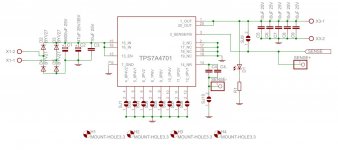 TPS7A4700_single_schematic.JPG92.4 KB · Views: 8,634
TPS7A4700_single_schematic.JPG92.4 KB · Views: 8,634 -
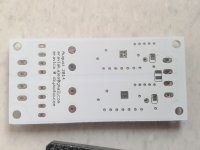 20141020_151926.jpg852.2 KB · Views: 2,388
20141020_151926.jpg852.2 KB · Views: 2,388 -
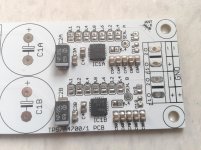 20141020_151919.jpg270.3 KB · Views: 2,681
20141020_151919.jpg270.3 KB · Views: 2,681 -
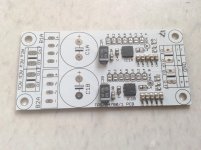 20141020_151909.jpg247.1 KB · Views: 1,726
20141020_151909.jpg247.1 KB · Views: 1,726 -
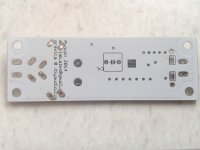 20141020_151900.jpg847.6 KB · Views: 1,889
20141020_151900.jpg847.6 KB · Views: 1,889 -
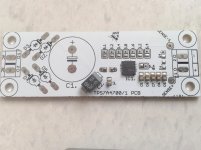 20141020_151852.jpg237.6 KB · Views: 2,367
20141020_151852.jpg237.6 KB · Views: 2,367 -
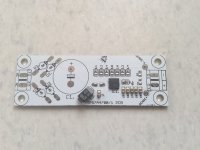 20141020_151823.jpg947.3 KB · Views: 7,909
20141020_151823.jpg947.3 KB · Views: 7,909 -
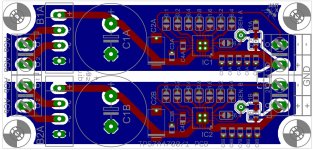 TPS7A4700_dual_PCB.JPG282.8 KB · Views: 8,031
TPS7A4700_dual_PCB.JPG282.8 KB · Views: 8,031 -
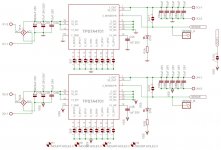 TPS7A4700_dual_scheme.JPG122.4 KB · Views: 8,156
TPS7A4700_dual_scheme.JPG122.4 KB · Views: 8,156 -
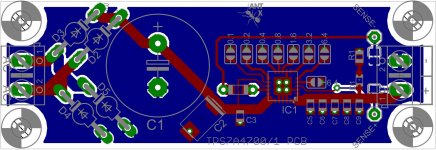 TPS7A4700_single_PCB.JPG178.3 KB · Views: 8,358
TPS7A4700_single_PCB.JPG178.3 KB · Views: 8,358
Last edited:
How much is one pcb single voltage pcbs with all parts?
Hi MASantos,
price for one single PCB is 19€(all parts)+3€ shipping= 22€.
Best Regards,
Ales
Does that mean that dual PCB will be able to handle 2A current ?
What is the price for Dual PCB ?
Thanks
Regards,
Kuni
Hi Kuni,
depends how you look at it. Dual PCB can handle 1A per voltage rail, so 1A for +12V and 1A for -12V. Price for one is 35€ and with Panasonic FR is 37€.
Best Regards,
Ales
I want to use voltage regulators for Audio PC linear PSU and see what maximum results can be achieved.
My thought is to use 7A current LT1083 for 12v, 2A your regulators for 3.3V and 2A your regulators for 5V. In that case I would require 4x your regulators.
Are you building higher current regulators and is it required to have that high end regulation for PC PSU at all ?
My thought is to use 7A current LT1083 for 12v, 2A your regulators for 3.3V and 2A your regulators for 5V. In that case I would require 4x your regulators.
Are you building higher current regulators and is it required to have that high end regulation for PC PSU at all ?
I want to use voltage regulators for Audio PC linear PSU and see what maximum results can be achieved.
My thought is to use 7A current LT1083 for 12v, 2A your regulators for 3.3V and 2A your regulators for 5V. In that case I would require 4x your regulators.
Are you building higher current regulators and is it required to have that high end regulation for PC PSU at all ?
Nice idea you have there, but if you connect two regulators TPS7A4700 outputs together in parallel it just won't work properly. For your application I recommend you to look for after LT3080 or LT3081, these regulators are made for current sharing. Linear regulation would definitely be better for PC than smps in therms of sound and noise levels.
Best Regards,
Ales
Last edited:
Hi Ales, just to let you know that my package arrived safely today. The board looks very nice.
A suggestion though, it would be good if you could make a simple user guide available. I know how to set the correct voltage but others won't. Also, I have a small heatsink plus a lump of metal with an Allen bolt; what's your thinking on the latter? And, what current/voltage range is the heatsink good for?
Thanks again
Ray
A suggestion though, it would be good if you could make a simple user guide available. I know how to set the correct voltage but others won't. Also, I have a small heatsink plus a lump of metal with an Allen bolt; what's your thinking on the latter? And, what current/voltage range is the heatsink good for?
Thanks again
Ray
Last edited:
Hi Ales, just to let you know that my package arrived safely today. The board looks very nice.
A suggestion though, it would be good if you could make a simple user guide available. I know how to set the correct voltage but others won't. Also, I have a small heatsink plus a lump of metal with an Allen bolt; what's your thinking on the latter? And, what current/voltage range is the heatsink good for?
Thanks again
Ray
Hi Ray,
thank you for your comment. I am currently working on a simple guide how to setup output voltage, what transformer to use and the purpose of those aluminum things etc... That aluminum is meant to be used as a heatbridge but I need to buy some standoffs to make presentation correct.
Best Regards,
Ales
Hi Ray,
thank you for your comment. I am currently working on a simple guide how to setup output voltage, what transformer to use and the purpose of those aluminum things etc... That aluminum is meant to be used as a heatbridge but I need to buy some standoffs to make presentation correct.
Best Regards,
Ales
Thanks Ales, it looks like your on the case...
I had assumed the aluminium thing was to couple the regulator chip to the chassis or a heatsink, sandwiched under the board. The standoffs will hold it in place right?
Ray
Thanks Ales, it looks like your on the case...
I had assumed the aluminium thing was to couple the regulator chip to the chassis or a heatsink, sandwiched under the board. The standoffs will hold it in place right?
Ray
Yeah, standoffs should hold it in a place, but you do need to use silicone thermal insulator pad between PCB and aluminum. You can also fix it to base with screw, the hole needs to be of 6mm diameter.
Simple user manual
Hi guys,
I made simple manual how to use these PCBs. I also did mounting plan for both PCBs, so drilling holes for mounting is easier and more accurate.
Best Regards,
Ales
Hi guys,
I made simple manual how to use these PCBs. I also did mounting plan for both PCBs, so drilling holes for mounting is easier and more accurate.
Best Regards,
Ales
Attachments
Last edited:
Hi Ales,
Received the package. Looks very nice! I'm thinking of using smd cap for c4. What do you recommend in place of epcos/wima? Thanks.
Best regards.
Darrell
Hi Darrell,
Thanks! I recommend you to use 1uF X7R 25V 0805 size, any manufacturer should be ok. Don't use X5R because it has lower temperature rating.
Best Regards,
Aleš
How much is it for one pcb dual voltage with all parts (including 3300mf panasonic)?
Thanks
Hello,
dual PCB is 35€ + 2€ (2x Panasonic FR) + 3€ priority shipping = 40€.
Best Regards,
Aleš
Hi Ales, I would like to use your supply as a pre-regulator for a clock/isolator board, similar to the Acko board.
The clocks and isolators will have onboard 3.3V regulation - a surface-mount LDO regulator for the isolators, and Paul Hynes-style shunt regulator for the clocks.
Your regulator would be supplying somewhere between 5V - 6V at a single connection to this board.
My (possibly stupid) question is - since your regulator will be supplying 2 different loads, is it still worth connecting the "sense" wires to the single connection point at the board?
Thanks.
The clocks and isolators will have onboard 3.3V regulation - a surface-mount LDO regulator for the isolators, and Paul Hynes-style shunt regulator for the clocks.
Your regulator would be supplying somewhere between 5V - 6V at a single connection to this board.
My (possibly stupid) question is - since your regulator will be supplying 2 different loads, is it still worth connecting the "sense" wires to the single connection point at the board?
Thanks.
Hi Ales, I would like to use your supply as a pre-regulator for a clock/isolator board, similar to the Acko board.
The clocks and isolators will have onboard 3.3V regulation - a surface-mount LDO regulator for the isolators, and Paul Hynes-style shunt regulator for the clocks.
Your regulator would be supplying somewhere between 5V - 6V at a single connection to this board.
My (possibly stupid) question is - since your regulator will be supplying 2 different loads, is it still worth connecting the "sense" wires to the single connection point at the board?
Thanks.
Hello,
yes, it is still worth connecting then sense wires to single connection point at the board. Regulator will eliminate voltage drop over the wires, therefore always supplying 5V directly on the board. How much current consumption does your board have?
Best Regards,
Aleš
- Home
- Vendor's Bazaar
- TPS7A4700 low noise LDO regulator PCB
